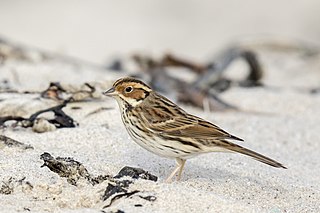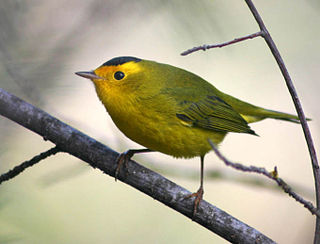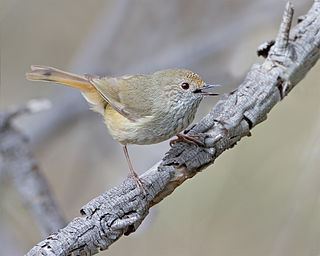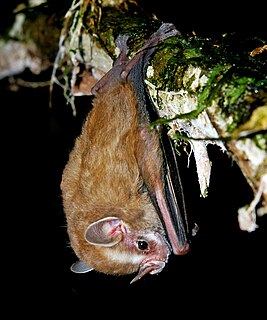Related Research Articles

The semipalmated sandpiper is a very small shorebird. The genus name is from Ancient Greek kalidris or skalidris, a term used by Aristotle for some grey-coloured waterside birds. The specific pusilla is Latin for "very small".

Baillon's crake, also known as the marsh crake, is a small waterbird of the family Rallidae.

The little bunting is a passerine bird belonging to the bunting family (Emberizidae).

Wilson's warbler is a small New World warbler. It is greenish above and yellow below, with rounded wings and a long, slim tail. The male has a black crown patch; depending on the subspecies, that mark is reduced or absent in the female. It breeds across Canada and south through the western United States, and winters from Mexico south through much of Central America. It is a very rare vagrant to western Europe.

The field sparrow is a small New World sparrow in the family Passerellidae. It is about 140 mm (6 in) long and weighs about 12.5 g (0.4 oz). The head is grey with a rust-coloured crown, white eye-ring and pink bill. The upper parts are brown streaked with black and buff, the breast is buff, the belly is white and the tail is forked. There are two different colour morphs, one being greyer and the other more rufous.

The Senegal eremomela is a member of the African warbler family, the Cisticolidae. It occurs in the savannas of western Sub-Saharan Africa.

The brown-headed nuthatch is a small songbird found in pine forests throughout the Southeastern United States. Genetic analyses indicated low differentiation between northern and southern populations in Florida, but the study also found lower genetic diversity among south Florida populations that may be a result of the increased habitat fragmentation that was documented. A population on the Bahamas showed moderate to high differentiation compared with Florida populations. The Bahama nuthatch was and still is considered a subspecies by several authorities including the IOC, but the IUCN and BirdLife International have reclassified it as its own separate species. Two recent studies assessing vocalizations in Bahama and continental nuthatch populations found important differences. One of the studies also demonstrated that continental and Bahama populations did not respond aggressively to calls of the other population. This type of call-response study is often used to help define cryptic species.

The brown thornbill is a passerine bird usually found in eastern and south-eastern Australia, including Tasmania. It can grow up to 10 cm (3.9 in) long, and feeds on insects. It is brown, grey and white. The species has five subspecies.
The least big-eared bat is a South American bat species of the family Phyllostomidae, found in northwestern Brazil and eastern Colombia. It is monotypic within its genus.

The southern little yellow-eared bat is a frugivorous bat species from South America. It is found in Brazil, Argentina and Paraguay.

The Chatham snipe or Chatham Island snipe is a species of wader in the family Scolopacidae. It is endemic to the Chatham Islands of New Zealand, and is only found on a few islands in the south of the Chatham Islands group.

The least shrew tenrec is a species of mammal in the family Tenrecidae. It is endemic to Madagascar. Its natural habitats are subtropical or tropical moist lowland forest, subtropical or tropical moist montane forest, swamps, pastureland, and irrigated land. It is threatened by habitat loss.

The steppe pika is a small mammal of the pika family, Ochotonidae. It is found in the steppes of southern Russia and northern Kazakhstan.

Micromonas is a genus of green algae in the family Mamiellaceae.

Malva pusilla, also known as Malva rotundifolia, the low mallow, small mallow, or the round-leaved mallow, is an annual and biennial herb species of the Mallow genus Malva in the family of Malvaceae. Malva is a genus that consists of about 30 species of plants. This genus consists of plants named mallows. Mallows grow in many regions, including temperate, subtropical, and tropical areas. (Persian: خبّازی، پنیرک)

Pterolophia is a genus of longhorn beetles of the subfamily Lamiinae, containing the following species:
Pterolophia instabilis is a species of beetle in the family Cerambycidae. It was described by Per Olof Christopher Aurivillius in 1922. It is known from Seychelles.
Pterolophia guineensis is a species of beetle in the family Cerambycidae. It was described by James Thomson in 1864, originally under the genus Alyattes.

Kogia pusilla is an extinct species of sperm whale from the Middle Pliocene of Italy related to the modern day dwarf sperm whale and pygmy sperm whale. It is known from a single skull discovered in 1877, and was considered a species of beaked whale until 1997. The skull shares many characteristics with other sperm whales, and is comparable in size to that of the dwarf sperm whale. Like the modern Kogia, it probably hunted squid in the twilight zone, and frequented continental slopes. The environment it inhabited was likely a calm, nearshore area with a combination sandy and hard-rock seafloor. K. pusilla likely died out due to the ice ages at the end of the Pliocene.
References
- ↑ BioLib.cz - Pterolophia pusilla. Retrieved on 8 September 2014.